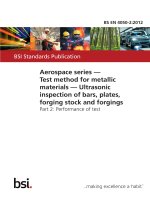Bsi bs en 61988 2 1 2012
Bạn đang xem bản rút gọn của tài liệu. Xem và tải ngay bản đầy đủ của tài liệu tại đây (1.36 MB, 38 trang )
BS EN 61988-2-1:2012
BSI Standards Publication
Plasma display panels
Part 2-1: Measuring methods —
Optical and optoelectrical
BRITISH STANDARD
BS EN 61988-2-1:2012
National foreword
This British Standard is the UK implementation of EN 61988-2-1:2012. It is
identical to IEC 61988-2-1:2012. It supersedes BS EN 61988-2-1:2002 and BS
EN 61988-2-2:2003, which are withdrawn.
The UK participation in its preparation was entrusted to Technical Committee
EPL/47, Semiconductors.
A list of organizations represented on this committee can be obtained on
request to its secretary.
This publication does not purport to include all the necessary provisions of a
contract. Users are responsible for its correct application.
© The British Standards Institution 2012
Published by BSI Standards Limited 2012
ISBN 978 0 580 65877 8
ICS 31.260
Compliance with a British Standard cannot confer immunity from
legal obligations.
This British Standard was published under the authority of the Standards
Policy and Strategy Committee on 30 April 2012.
Amendments issued since publication
Amd. No.
Date
Text affected
BS EN 61988-2-1:2012
EUROPEAN STANDARD
EN 61988-2-1
NORME EUROPÉENNE
March 2012
EUROPÄISCHE NORM
ICS 31.260
Supersedes EN 61988-2-1:2002, EN 61988-2-2:2003
English version
Plasma display panels Part 2-1: Measuring methods Optical and optoelectrical
(IEC 61988-2-1:2012)
Panneaux d'affichage à plasma Partie 2-1: Méthodes de mesure Mesures optiques et opto-électriques
(CEI 61988-2-1:2012)
Plasmabildschirme Teil 2-1: Messverfahren – Optisch und
opto-elektrisch
(IEC 61988-2-1:2012)
This European Standard was approved by CENELEC on 2012-02-28. CENELEC members are bound to comply
with the CEN/CENELEC Internal Regulations which stipulate the conditions for giving this European Standard
the status of a national standard without any alteration.
Up-to-date lists and bibliographical references concerning such national standards may be obtained on
application to the CEN-CENELEC Management Centre or to any CENELEC member.
This European Standard exists in three official versions (English, French, German). A version in any other
language made by translation under the responsibility of a CENELEC member into its own language and notified
to the CEN-CENELEC Management Centre has the same status as the official versions.
CENELEC members are the national electrotechnical committees of Austria, Belgium, Bulgaria, Croatia, Cyprus,
the Czech Republic, Denmark, Estonia, Finland, France, Germany, Greece, Hungary, Iceland, Ireland, Italy,
Latvia, Lithuania, Luxembourg, Malta, the Netherlands, Norway, Poland, Portugal, Romania, Slovakia, Slovenia,
Spain, Sweden, Switzerland, Turkey and the United Kingdom.
CENELEC
European Committee for Electrotechnical Standardization
Comité Européen de Normalisation Electrotechnique
Europäisches Komitee für Elektrotechnische Normung
Management Centre: Avenue Marnix 17, B - 1000 Brussels
© 2012 CENELEC -
All rights of exploitation in any form and by any means reserved worldwide for CENELEC members.
Ref. No. EN 61988-2-1:2012 E
BS EN 61988-2-1:2012
EN 61988-2-1:2012
-2-
Foreword
The text of document 110/337/FDIS, future edition 2 of IEC 61988-2-1, prepared by IEC TC 110, "Flat
panel display devices" was submitted to the IEC-CENELEC parallel vote and approved by CENELEC as
EN 61988-2-1:2012.
The following dates are fixed:
•
•
latest date by which the document has
to be implemented at national level by
publication of an identical national
standard or by endorsement
latest date by which the national
standards conflicting with the
document have to be withdrawn
(dop)
2012-11-28
(dow)
2015-02-28
This document supersedes EN 61988-2-1:2002 and EN 61988-2-2:2003.
EN 61988-2-1:2012 includes the following significant technical changes with respect to EN 61988-21:2002:
– EN 61988-2-1:2002 and EN 61988-2-2:2003 were combined and reconstructed in this document.
Attention is drawn to the possibility that some of the elements of this document may be the subject of
patent rights. CENELEC [and/or CEN] shall not be held responsible for identifying any or all such patent
rights.
Endorsement notice
The text of the International Standard IEC 61988-2-1:2012 was approved by CENELEC as a European
Standard without any modification.
In the official version, for Bibliography, the following notes have to be added for the standards indicated:
IEC 61988-2-1
NOTE Harmonized as EN 61988-2-1.
IEC 61988-2-2
NOTE Harmonized as EN 61988-2-2.
BS EN 61988-2-1:2012
EN 61988-2-1:2012
-3-
Annex ZA
(normative)
Normative references to international publications
with their corresponding European publications
The following documents, in whole or in part, are normatively referenced in this document and are
indispensable for its application. For dated references, only the edition cited applies. For undated
references, the latest edition of the referenced document (including any amendments) applies.
NOTE When an international publication has been modified by common modifications, indicated by (mod), the relevant EN/HD
applies.
Publication
Year
Title
EN/HD
Year
IEC 60068-1
-
Environmental testing Part 1: General and guidance
EN 60068-1
-
IEC 60107-1
-
Methods of measurement on receivers for
EN 60107-1
television broadcast transmissions Part 1: General considerations Measurements at radio and video frequencies
-
IEC 61988-1
-
Plasma display panels Part 1: Terminology and letter symbols
EN 61988-1
-
IEC 62087
-
Methods of Measurement for the power
consumption of audio, video and related
equipment
EN 62087
-
CIE 15
-
Colorimetry
-
-
–2–
BS EN 61988-2-1:2012
61988-2-1 IEC:2012
CONTENTS
1
Scope ............................................................................................................................... 6
2
Normative references ....................................................................................................... 6
3
Terms and definitions ....................................................................................................... 6
4
Structure of measuring equipment .................................................................................... 7
5
Standard measuring conditions ......................................................................................... 7
5.1
5.2
6
Environmental conditions ........................................................................................ 7
Set-up conditions .................................................................................................... 7
5.2.1 General ....................................................................................................... 7
5.2.2 Measuring layout ......................................................................................... 8
5.2.3 Field frequency ............................................................................................ 8
5.2.4 Adjustment of PDP modules ........................................................................ 9
5.2.5 Warm-up condition of PDP modules ............................................................ 9
5.3 Lighting conditions .................................................................................................. 9
5.3.1 Dark-room conditions .................................................................................. 9
5.3.2 Bright-room conditions ................................................................................. 9
Measuring methods ........................................................................................................ 11
6.1
6.2
6.3
6.4
6.5
6.6
6.7
Measuring methods of 4 % window luminance ....................................................... 11
6.1.1 Purpose ..................................................................................................... 11
6.1.2 Measuring equipment ................................................................................ 11
6.1.3 Measurement............................................................................................. 11
Measuring method of luminance uniformity ............................................................ 12
6.2.1 Purpose ..................................................................................................... 12
6.2.2 Measuring equipment ................................................................................ 12
6.2.3 Measurement............................................................................................. 12
Measuring method of dark-room contrast ratio ....................................................... 13
6.3.1 Purpose ..................................................................................................... 13
6.3.2 Measuring equipment ................................................................................ 13
6.3.3 Measurement............................................................................................. 14
Measuring method of bright-room contrast ratio 100/70 ......................................... 15
6.4.1 General ..................................................................................................... 15
6.4.2 Purpose ..................................................................................................... 15
6.4.3 Measuring equipment ................................................................................ 15
6.4.4 Measurement............................................................................................. 15
Measuring method of white chromaticity and chromatic uniformity ......................... 16
6.5.1 Purpose ..................................................................................................... 16
6.5.2 Measuring equipment ................................................................................ 16
6.5.3 Measurement............................................................................................. 16
Measuring method of colour gamut ........................................................................ 17
6.6.1 Purpose ..................................................................................................... 17
6.6.2 Measuring equipment ................................................................................ 17
6.6.3 Measurement............................................................................................. 17
Measuring method of module power and current consumption ............................... 18
6.7.1 Purpose ..................................................................................................... 18
6.7.2 Measuring equipment ................................................................................ 18
6.7.3 Measurement............................................................................................. 19
BS EN 61988-2-1:2012
61988-2-1 IEC:2012
–3–
6.8
Measuring method of module power consumption using video signal ..................... 21
6.8.1 General ..................................................................................................... 21
6.8.2 Measuring equipment ................................................................................ 21
6.8.3 Applied digital video signal ........................................................................ 21
6.8.4 Image processing board ............................................................................ 21
6.8.5 Measurement............................................................................................. 22
6.9 Measuring method of module luminous efficacy ..................................................... 23
6.9.1 Purpose ..................................................................................................... 23
6.9.2 Measuring equipment ................................................................................ 23
6.9.3 Measurement............................................................................................. 23
6.10 Measuring method of panel luminous efficacy ....................................................... 24
6.10.1 Purpose ..................................................................................................... 24
6.10.2 Measuring equipment ................................................................................ 24
6.10.3 Panel conditions ........................................................................................ 25
6.10.4 Driving waveform ....................................................................................... 26
6.10.5 Applied display patterns ............................................................................ 27
6.10.6 Measurement............................................................................................. 27
Annex A (informative) Clause cross-references from the previous edition of
IEC 61988-2-1:2002 and IEC 61988-2-2:2003 to IEC 61988-2-1:2011................................... 31
Bibliography .......................................................................................................................... 33
Figure 1 – Measuring layout (side view) .................................................................................. 8
Figure 2 – Example of bright-room conditions ....................................................................... 10
Figure 3 – 4 % window luminance measuring pattern ............................................................ 11
Figure 4 – Measuring points .................................................................................................. 13
Figure 5 – Minimum luminance measuring pattern ................................................................ 15
Figure 6 – Example of the colour gamut measurement .......................................................... 18
Figure 7 – Example of power and current measuring diagram ............................................... 19
Figure 8 – System diagram of sustain power measurement ................................................... 25
Figure 9 – Driving system and waveform ............................................................................... 27
Table 1 – Example of luminance uniformity measurement ..................................................... 13
Table 2 – Example of chromaticity measurement .................................................................. 17
Table 3 – Example of power and current measurements (for a module that includes an
AC input) .............................................................................................................................. 20
Table 4 – Example of power and current measurement (for a module with DC inputs
only) ..................................................................................................................................... 20
Table 5 – Example of measurement results of module power consumption using video
signal .................................................................................................................................... 22
Table A.1 – Clause cross-references ..................................................................................... 32
–6–
BS EN 61988-2-1:2012
61988-2-1 IEC:2012
PLASMA DISPLAY PANELS –
Part 2-1: Measuring methods –
Optical and optoelectrical
1
Scope
This part of IEC 61988 determines the following measuring methods for characterizing the
performance of plasma display modules (PDP modules):
a) four per cent (4 %) window luminance;
b) luminance uniformity;
c) dark-room contrast ratio;
d) bright-room contrast ratio 100/70;
e) white chromaticity and chromatic uniformity;
f)
colour gamut in the centre box;
g) module power and current consumption;
h) module power consumption using video signal;
i)
module luminous efficacy, and
j)
panel luminous efficacy.
2
Normative references
The following documents, in whole or in part, are normatively referenced in this document and
are indispensable for its application. For dated references, only the edition cited applies. For
undated references, the latest edition of the referenced document (including any
amendments) applies.
IEC 60068-1, Environmental Testing – Part 1: General and guidance
IEC 60107-1, Methods of measurement on receivers for television broadcast transmissions –
Part 1: General considerations – Measurements at radio and video frequencies
IEC 61988-1, Plasma display panels – Part 1: Terminology and letter symbols
IEC 62087, Methods of measurement for the power consumption of audio, video and related
equipment
CIE 15:2004, Colorimetry
3
Terms and definitions
For the purposes of this document, the terms and definitions given in IEC 61988-1,
IEC 60068-1, and IEC 60107-1, as well as the following, apply.
BS EN 61988-2-1:2012
61988-2-1 IEC:2012
–7–
3.1
4 % window panel luminous efficacy
η p0,04
panel luminous efficacy measured by displaying the patterns of 4 % white window and full
screen black
NOTE
Ohmic loss is smaller than that of full screen panel luminous efficacy (see 3.4).
3.2
full screen panel luminous efficacy
η p,fs
panel luminous efficacy measured by displaying the patterns of full screen white and full
screen black
NOTE
Ohmic loss is larger than that of 4 % window panel luminous efficacy (see 3.4).
3.3
panel checker
system used to drive and test plasma display panel
NOTE
Panel checker includes the same or the equivalent electric circuits as a PDP module.
3.4
panel luminous efficacy
luminous efficacy
η
incremental luminous flux (measured as the luminous flux of a white display minus the
luminous flux of a black display) divided by the incremental power input applied to the sustain
driver for operating the panel (measured as the white display power minus the black display
power)
NOTE
4
Expressed in lumens/watt.
Structure of measuring equipment
The system diagrams and/or driving conditions of the measuring equipment shall comply with
the structure specified in each item.
5
Standard measuring conditions
5.1
Environmental conditions
Measurements shall be carried out under the standard environmental conditions, i.e. at a
temperature of 25 °C ± 3 °C, a relative humidity of 25 % to 85 %, and a pressure of 86 kPa to
106 kPa. When different environmental conditions are used, these shall be noted on the
report.
5.2
5.2.1
Set-up conditions
General
The following standard set-up conditions shall be used. Each condition shall be noted on the
relevant specification whenever any different conditions other than the standard set-up
conditions are applied.
BS EN 61988-2-1:2012
61988-2-1 IEC:2012
–8–
5.2.2
5.2.2.1
Measuring layout
General
Measurements shall be carried out at the standard measuring layout shown in Figure 1. When
a different measuring layout is used, this shall be noted on the report.
5.2.2.2
Position of light measuring device
The light measuring device shall be aligned perpendicular to the area to be measured on the
screen of the PDP module.
5.2.2.3
Standard measuring distance
The standard measuring distance xo is 2,5 V, where V is the screen height or the short side
length of the screen. The measuring distance shall be between 1,6 V and 2,8 V. The
measuring distance shall be noted on the report.
5.2.2.4
Aperture angle of light measuring device
The light measuring device shall be set at a proper aperture angle less than or equal to
2 degrees, and shall measure an area of at least 500 pixels which has an extent less than
10 % of the screen height. This area corresponds to including a circular measurement area of
at least 26 lines in diameter in the case of a display panel having a square pixel consisting of
3 subpixels. The measuring distance and the aperture angle may be adjusted to achieve a
viewing area greater than 500 pixels, which has an extent less than 10 % of the screen height
if setting the above aperture angle is difficult. Such deviations from standard conditions shall
be noted on the report.
Display surface
Plasma display
module
Light measuring device
Perpendicular to screen
Measuring point
Driving
power
source
Driving
signal
equipment
Xo
IEC
44/12
Key
X0 standard measuring distance = 2,5 V, where V is the screen height or short side length of screen.
Figure 1 – Measuring layout (side view)
5.2.3
Field frequency
The standard field frequency of the driving signal equipment shall be 60 Hz, unless the
module is intended to be used at a significantly different frequency. In any case, the field
frequency used shall be noted on the report.
BS EN 61988-2-1:2012
61988-2-1 IEC:2012
5.2.4
–9–
Adjustment of PDP modules
For contrast adjustable PDP modules, adjust the contrast to the maximum value under the
standard environmental conditions.
Automatic control functions such as auto-power control (APC), image sticking prevention
function, etc. by which the display luminance could change during the measurement shall be
turned off or the activation of these functions shall be avoided by some measuring procedures
described below.
When the displayed luminance could be changed by some automatic control functions
included in the PDP module and turning off these functions is not convenient, a procedure
using sequentially changing input images or a procedure using a turn-on, measure and turnoff sequence shall be applied.
For the procedure of sequentially changing input images, the input signals shall be changed
just before the display luminance is changed and the measurement shall be carried out when
the measured image is displayed. The input signal, except the measured image, should be
any suitable signal that disables the automatic control functions mentioned above.
For the procedure of using a turn-on, measure and turn-off sequence, the PDP module shall
be sequentially turned off and turned on just before the displayed luminance is changed. The
measurement shall be carried out when the measured image is displayed.
The displayed luminance of both procedures mentioned above usually remains constant for
several minutes which are enough for a stable measurement with a light measurement device.
5.2.5
Warm-up condition of PDP modules
The warm-up time shall be longer than 30 minutes with a signal input set at 15 % grey level
on full screen without gamma correction, unless other specified measuring methods are used.
When different warm-up conditions are used, they shall be noted on the report.
5.3
Lighting conditions
5.3.1
Dark-room conditions
Illuminance shall be less than 1 lx anywhere on the screen of the PDP module. When this
illuminance significantly affects the measurement of the black level, the background
subtraction method shall be used. When a different illuminance or the background subtraction
method is used, this shall be noted on the report.
5.3.2
5.3.2.1
Bright-room conditions
General
The lamp shall be adjusted so that the illuminance conditions on vertical and horizontal
planes are satisfied at the centre of the panel, which has been arranged vertically.
The illuminance precision shall be ± 5 % and the measured illuminance shall be clearly noted
on the report. When a different illuminance is used, it shall be noted on the report.
5.3.2.2
Illuminance on the panel
a) Vertical plane illuminance:
100 lx
b) Horizontal plane illuminance:
70 lx
5.3.2.3
Illumination source
AAA colour rendering daylight white (JIS Z 9112-1990 type N-EDL) straight tube fluorescent
lamp should be used. If another kind of lamp is used, it shall be noted on the report with the
BS EN 61988-2-1:2012
61988-2-1 IEC:2012
– 10 –
detail information of the lamp. When the illuminance conditions cannot be met with one lamp,
a group of lamps may be used. It is permissible to use luminance adjustable lamps.
The fluorescent lamp(s) shall be used under the recommended operation conditions: for
example, after 100 hours of ageing but before they have been in use for 2 000 h. Photo
spectrum of the applied lamps shall be included in the detail information.
5.3.2.4
Placement of illumination source and display
The panel shall be mounted in a vertical plane. The long axis of lamp shall be arranged
horizontal to the floor and parallel to the plane of the panel. The centre of the lamp shall be
arranged within a normal vertical plane which is normal to the panel face and intersects the
centre of the panel (see Figure 2).
(Ceiling height: 2,40 m)
Horizontal plane
illuminance at
centre of panel
Black baffle
Light measuring
device
Vertical plane
illuminance
Luminance adjustable
fluorescent lamp(s)
(6 × 40 W tubes)
Plasma display
module
(Height at screen
centre: 0,70 m)
Side view
Horizontal distance
between lamp and
panel: 2,43 m
Movable
Plasma display
module
Luminance adjustable fluorescent
lamp(s) (6 × 40 W tubes)
Light measuring device
NOTE
Black baffle
Normal vertical plane
Top view
Details in brackets are for example only.
IEC
45/12
Figure 2 – Example of bright-room conditions
5.3.2.5
Adjustment of illuminance
The illumination shall be adjusted – by adjusting the illumination source output and/or the
position of the lamp(s), and/or by moving the display panel – so that the vertical plane and
horizontal plane illuminance conditions are satisfied. When measuring the illuminance, the
display shall be moved from the measurement position, in order to avoid the light reflection
from the display.
BS EN 61988-2-1:2012
61988-2-1 IEC:2012
5.3.2.6
– 11 –
Others
The walls shall be hung with black curtains, or shall be windowless and grey in colour with a
reflectivity no greater than 20 %. And the floor shall be grey in colour with a reflectivity no
greater than 20 %.
Consideration shall be given to the colour and placement of the measurement system,
including walls, floor, ceiling and persons making the measurements, so that reflected light
does not affect the measured illuminance. A black baffle plate shall be applied to reduce the
reflected light, without shadowing the panel. Once the light source has been turned on, the
illuminance shall be adjusted after it has reached a sufficient stability. An example of a
measurement room is shown in Figure 2.
6
Measuring methods
6.1
6.1.1
Measuring methods of 4 % window luminance
Purpose
The purpose of this method is to measure the luminance of a 4 % window of a PDP module.
6.1.2
Measuring equipment
The following equipment shall be used:
a) driving power source;
b) driving signal equipment; and
c) light measuring device.
6.1.3
Measurement
The PDP module shall be set in the standard measuring conditions and in the dark-room
conditions. The measuring layout is shown in Figure 1. Apply a 4 % window (H/5 × V/5) white
signal of level 100 % at the screen centre to the PDP module and measure the 4 % window
luminance L DR0,04 at the centre P 0 of the white window A 0 as shown in Figure 3.
2V/5
Measuring point
V
V/5
2H/5
H/5
H
IEC
46/12
Figure 3 – Four per cent (4 %) window luminance measuring pattern
– 12 –
6.2
6.2.1
BS EN 61988-2-1:2012
61988-2-1 IEC:2012
Measuring method of luminance uniformity
Purpose
The purpose of this method is to measure the luminance uniformity of a PDP module.
6.2.2
Measuring equipment
The following equipment shall be used:
a) driving power source;
b) driving signal equipment; and
c) light measuring device.
6.2.3
Measurement
The PDP module shall be set in the standard measuring conditions and in the dark-room
conditions. The measuring layout is shown in Figure 1. Apply a full screen white signal of
level 100 % to the PDP module and measure the luminance L i at the specified points P i
(where i is 0 to 8 or 0 to 4) on the display screen. Measurements shall be carried out at
five points or nine points. In the case of the display screen shown in Figure 4, measuring
points shall be chosen from P 0 to P 4 or from P 0 to P 8 for five points or nine points,
respectively. The luminance non-uniformity at P i is:
∆Li
L av
× 100 (%)
Where, luminance deviation ∆ L i is given by:
∆ L i = L i - L av
Average luminance L av for five points is given by:
L av =
L0 + L1 + L2 + L 3 + L4
5
Or average luminance L av for nine points is given by:
L av =
L0 + L1 + L2 + L3 + L4 + L5 + L6 + L7 + L 8
9
The measured results should be recorded as shown in Table 1.
BS EN 61988-2-1:2012
61988-2-1 IEC:2012
– 13 –
H/2
V/10
P1
P5
P2
P8
P0
P6
P4
P7
P3
V/2
H/10
H
NOTE
V
P 0 to P 8 ; Measuring points
IEC
47/12
Figure 4 – Measuring points
Table 1 – Example of luminance uniformity measurement
Measuring point
Luminance
Li
cd/m 2
Luminance non-uniformity
∆ L i / L av × 100
%
P0
110
+1,6
P1
107
-1,1
P2
109
+0,7
P3
106
-2,1
P4
104
-3,9
P5
111
+2,6
P6
113
+4,4
P7
105
-3,0
109
+0,7
P8
Average luminance L av : 108
6.3
6.3.1
cd/m 2
Measuring method of dark-room contrast ratio
Purpose
The purpose of this method is to measure the dark-room contrast ratio of a PDP module.
6.3.2
Measuring equipment
The following equipment shall be used:
a) driving power source;
b) driving signal equipment; and
– 14 –
BS EN 61988-2-1:2012
61988-2-1 IEC:2012
c) light measuring device.
6.3.3
6.3.3.1
Measurement
General setting
The PDP module shall be set in the standard measuring conditions and in the dark-room
conditions. The measuring layout is shown in Figure 1.
6.3.3.2
Measurement of 4 % window luminance
Apply the testing input signal displaying the 4 % window A 0 having a size of H/5 × V/5 (see
Figure 3) shall be applied to the PDP module from the driving signal equipment. Arrange the
testing input signal to obtain maximum luminance (100 %) on the 4 % window and minimum
luminance (0 %, black screen) on the other part of the screen. Measure the 4 % window
luminance L DR0,04 at the centre of the white window.
6.3.3.3
Measurement of minimum luminance
Apply the testing input signal displaying one by one each of the four white windows A 1 to A 4
shown in Figure 5 to the PDP module from the driving signal equipment. Arrange the testing
input signals to obtain maximum luminance (100 %) on the white window and minimum
luminance (0 %, black screen) on the other part of the screen. Measure the luminance L BRimin
(where i is 1 to 4) at the "luminance measuring position" P 0 in Figure 5 (same position in
Figure 3) when Ai (where i is 1 to 4) is lit with maximum luminance. Minimum luminance
L DRmin is defined as follows.
L DRmin =
L DR1min + L DR2min + L DR3min + L DR4min
4
If the above four measurements L BRimin (where i is 1 to 4) are sufficiently uniform (less than
5 % variation), it is permitted to measure only one luminance (e.g., L BR1min ) as minimum
luminance L BRmin . In this case the measured display pattern shall be noted on the report.
Use a black baffle in case stray light from A 1 to A 4 has an effect on the minimum luminance
measurement.
6.3.3.4
Procedure to determine the dark-room contrast ratio
The dark-room contrast ratio (DRCR) is given as follows:
BS EN 61988-2-1:2012
61988-2-1 IEC:2012
DRCR =
– 15 –
L DR0,04
L DRmin
V/5
A1
A2
V/5
A3
A4
H/5
H/5
V/5
Luminance measuring position
(same position in Figure 3)
V/5
NOTE
H/5
H/5
Light one window at a time.
IEC
48/12
Figure 5 – Minimum luminance measuring pattern
6.4
Measuring method of bright-room contrast ratio 100/70
6.4.1
General
The bright-room contrast ratio 100/70 (BRCR-100/70) is the value set in the condition where
the vertical plane illuminance is 100 lx and the horizontal plane illuminance is 70 lx.
6.4.2
Purpose
The purpose of this method is to measure the bright-room contrast ratio 100/70 of a PDP
module.
6.4.3
Measuring equipment
The following equipment shall be used:
a) driving power source;
b) driving signal equipment; and
c) light measuring device.
6.4.4
6.4.4.1
Measurement
General setting
The PDP module shall be set in the standard measuring conditions and in the bright-room
conditions. The measuring layout is shown in Figure 1 and Figure 2.
6.4.4.2
Measurement of 4 % window luminance
Apply the testing input signal displaying a 4 % window A 0 having a size of H/5 × V/5 (see
Figure 3) to the PDP module from the driving signal equipment. Arrange the testing input
signal to obtain maximum luminance (100 %) on the 4 % window and minimum luminance
(0 %, black screen) on the other part of the screen.
Measure the 4 % window luminance L BR0,04 at the centre of the white window.
– 16 –
6.4.4.3
BS EN 61988-2-1:2012
61988-2-1 IEC:2012
Measurement of minimum luminance
Apply the testing input signal displaying one by one each of the four white windows (A 1 to A 4 )
having a size H/5 × V/5 (see Figure 5) to the PDP module from the driving signal equipment.
Arrange the testing input signals to obtain maximum luminance (100 %) on the white window
and minimum luminance (0 %, black screen) on the other part of the screen. Measure the
luminance L BRimin (where i is 1 to 4) at the "luminance measuring position" P 0 in Figure 5
(same position in Figure 3) when Ai (where i is 1 to 4) is lit with maximum luminance.
Minimum luminance L BRmin is defined as follows.
L BRmin =
L BR1min + L BR2min + L BR3min + L BR4min
4
If the above four measurements L BRimin (where i is 1 to 4) are sufficiently uniform (less than
5 % variation), it is permitted to measure only one luminance (e.g., L BR1min ) as minimum
luminance L BRmin . In this case the measured display pattern shall be noted on the report.
6.4.4.4
Procedure to determine the bright-room contrast ratio 100/70
The bright-room contrast ratio 100/70 (BRCR-100/70) is given as follows:
BRCR-100/70 =
L BR0,04
L BRmin
If AAA colour rendering daylight white (JIS Z 9112-1990 type N-EDL) straight tube fluorescent
lamp is not available and other kind of lamp is used for the illumination source, it should be
noted on the report with the detail information of the applied lamp.
6.5
6.5.1
Measuring method of white chromaticity and chromatic uniformity
Purpose
The purpose of this method is to measure the white chromaticity and chromatic uniformity
(defined as chromaticity deviation) of the display surface of a PDP module.
6.5.2
Measuring equipment
The following equipment shall be used:
a) driving power source;
b) driving signal equipment; and
c) light measuring device.
6.5.3
Measurement
The PDP module shall be set in the standard measuring conditions and in the dark-room
conditions. The measuring layout is shown in Figure 1. Apply a full screen white input signal
of 100 % to the PDP module and measure the white chromaticity C (x y) at the specified
measuring points on the display screen. Where x and y are CIE1931 chromaticity coordinates
defined in CIE 15. Measurement shall be carried out at 1 point (only for white chromaticity
measurement), five points, or nine points. In the case of the display screen shown in Figure 4,
measuring points shall be chosen from P 0 , from P 0 to P 4 or from P 0 to P 8 for one point, five
points or nine points, respectively. The white chromaticity measured at P i is defined as C i (x
y i ). When each white chromaticity corresponding to P 0 , P 1 . . . P 8 is C 0 (x 0 y 0 ), C 1 (x 1 y 1 ),. . .
C 8 (x 8 y 8 ), each chromaticity deviation ∆ x i , ∆ y i is given by:
∆xI = xi - x 0, ∆yI = y i - y0
Where i is 1 to 8.
BS EN 61988-2-1:2012
61988-2-1 IEC:2012
– 17 –
The measured results should be recorded as given in Table 2.
NOTE It is permitted to use the following chromaticity deviation ∆ u' i , ∆ v' i at each measuring point P i after
transforming x, y chromaticity coordinates to u', v' chromatic coordinates.
∆ u' i = u' i - u' 0 , ∆ v' i = v' i - v' 0
Where i is 1 to 8. And u' and v' are CIE 1976 UCS diagram coordinates defined in CIE 15. Where u' = 4x / (3 - 2x +
12y), v' = 9y / (3 - 2x + 12y).
Table 2 – Example of chromaticity measurement
Measuring point
xi
∆ xi
yi
∆ yi
P0
0,282
0,000
0,282
0,000
P1
0,280
-0,002
0,283
+0,001
P2
0,278
-0,004
0,280
-0,002
P3
0,279
-0,003
0,285
+0,003
P4
0,282
0,000
0,283
+0,001
P5
0,277
-0,005
0,279
-0,003
P6
0,274
-0,008
0,276
-0,006
P7
0,283
+0,001
0,282
0,000
P8
0,280
-0,002
0,285
+0,003
6.6
6.6.1
Measuring method of colour gamut
Purpose
The purpose of this method is to measure the colour gamut of a PDP module.
6.6.2
Measuring equipment
The following equipment shall be used:
a) driving power source;
b) driving signal equipment; and
c) light measuring device.
6.6.3
Measurement
The PDP module shall be set in the standard measuring conditions and in the dark-room
conditions. The measuring layout is shown in Figure 1. Apply monochromatic 4 % window
signals (H/5 x V/5) of 100 % level corresponding to colour signal R, G, and B to the PDP
module (see Figure 3). Input R signal and then measure the CIE 1931 chromaticity coordinate
(x R y R ) (see CIE 15) at the centre of the window. In the same way, measure the chromaticity
coordinate (x G y G ) for G signal and the chromaticity coordinate (x B y B ) for B signal. Draw
straight lines connecting the three points (x R y R ), (x G y G ), and (x B y B ) on the chromaticity
diagram. An example of measuring results is shown in Figure 6.
NOTE It is permitted to use the following chromaticity coordinate u', v' of CIE 1976 UCS chromaticity diagram
(see CIE 15) transformed from chromaticity coordinate x, y given by:
BS EN 61988-2-1:2012
61988-2-1 IEC:2012
– 18 –
4x
3 - 2x + 12y
u' =
, v' =
9y
3 - 2x + 12y
0,9
0,8
(0,21 0,71)
0,7
0,6
y
0,5
0,4
(0,67 0,33)
0,3
0,2
0,1
(0,14 0,08)
0
0
0,1
0,2
0,3
0,4
0,5
0,6
0,7
0,8
x
IEC
49/12
Figure 6 – Example of the colour gamut measurement
6.7
Measuring method of module power and current consumption
6.7.1
Purpose
The purpose of this method is to measure the power and current consumption of a PDP
module.
6.7.2
Measuring equipment
The following equipment shall be used:
a) driving power source;
b) driving signal equipment;
c) AC voltmeter;
d) AC powermeter;
e) DC ammeter;
f)
DC voltmeter; and
g) any other equipment required to measure maximum power.
BS EN 61988-2-1:2012
61988-2-1 IEC:2012
– 19 –
The type or model number of the AC voltmeter, AC powermeter, DC ammeter and DC
voltmeter used for the measurement shall be recorded on the measurement log, which shall
also carry details of any equipment required to measure maximum power.
6.7.3
6.7.3.1
Measurement
General
The PDP module shall be set in the standard measuring conditions. The power supplied to the
module shall be measured as follows (see Figure 7 for an illustrative example). Measure both
the AC power and the DC power supplied from the external power sources. For each power
source, record the voltage, current and power values and the intended application of the
power (see Table 3 and Table 4 as illustrative examples). The sum of the powers supplied by
the power sources is taken as the total power consumption of the module. The voltage applied
to each circuit shall be the standard voltage specified on the relevant specification sheet.
PDP module
Display
signal
Built-in
power supply
Voltmeter
Ammeter
Ammeter
E1
I2
I3
Powermeter
AC power source
AC
DC power source
(floating)
DC2
DC power source
(with ground)
DC3
P1
Voltmeter
E2
Voltmeter
E3
GND
IEC
Figure 7 – Example of power and current measuring diagram
50/12
BS EN 61988-2-1:2012
61988-2-1 IEC:2012
– 20 –
Table 3 – Example of power and current measurements
(for a module that includes an AC input)
Measured power and current for
Full screen white display
Voltage
V
Current
A
Power
W
Remarks
1
AC 100 V system
112,5
–
P1
50 Hz
2
DC 5 V system
5,10
3,13
P 2 (5,10×3,13)
Signal processing etc.
3
⋅⋅⋅⋅ ⋅⋅⋅⋅
E3
I3
P3 (E3 × I3)
⋅⋅⋅⋅
⋅⋅⋅⋅
⋅⋅⋅⋅
–
–
P 1 +P 2 +P 3 +…+…
Total
Total power consumption:
Pm
⋅⋅⋅⋅ ⋅⋅⋅⋅
Power sources
⋅⋅⋅⋅
No.
Table 4 – Example of power and current measurement
(for a module with DC inputs only)
Measured power and current for
Full screen white display
No.
Power sources
Voltage
V
Current
A
Power
W
Remarks
1
160 V system
161
1,53
P 1 (161×1,53)
Sustain
2
70 V system
71,0
1,13
P 2 (71,0×1.13)
Addressing, floating
3
40 V system
E3
I3
P 3 (E 3 ×I 3 )
Address/data bias
⋅⋅⋅⋅
⋅⋅⋅⋅
⋅⋅⋅⋅
⋅⋅⋅⋅
⋅⋅⋅⋅
⋅⋅⋅⋅
Total
Total power consumption:
Pm
–
–
P 1 +P 2 +P 3 +…+…
6.7.3.2
Measurement of power and current for full screen white display
Apply a white input signal of level 100 % to all of the pixels in the PDP module to obtain a full
screen white display. Measurements shall be carried out after currents and voltages have
stabilised.
6.7.3.3
Measurement of power and current for full screen black display
Apply a black input signal of level 0 % to all of the pixels in the PDP module to obtain a full
screen black display. Measurements shall be carried out after currents and voltages have
stabilised.
6.7.3.4
Measurement of maximum power and current consumption
If, due to the design of the module, the display signal that results in maximum power
consumption is different from the above-mentioned full screen white display, the
measurements shall be carried out under the conditions that give maximum power
consumption. The conditions for maximum power consumption and the nature of the
measuring method shall be noted on each specification sheet.
BS EN 61988-2-1:2012
61988-2-1 IEC:2012
– 21 –
Since the maximum power consumption of a PDP module will vary according to the design of
the module's power limiting and protection circuits etc. The image displayed at maximum
power consumption will therefore also vary. A PDP module generally incorporates circuits
which, when a fixed image is being displayed, gradually reduce the luminance of the display
and hence the power consumption, and this means that maximum power consumption cannot
be measured under perfectly stable conditions. Measurements shall therefore be carried out
under the conditions that will result in maximum power consumption for a given module
design. The optimum measuring method for a given module design and set of measuring
conditions shall be adopted, and the method used shall be noted on the specification sheet.
6.8
Measuring method of module power consumption using video signal
6.8.1
General
The purpose of this method is to measure the module average power consumption using
video signal. This method reflects the method of “On (average) mode power consumption” for
TV set specified in IEC 62087, and is modified for a module measurement.
6.8.2
Measuring equipment
The following equipment shall be used. AC measuring equipment e) and f) noted below are
used when some or all of the power supplies are built into the module and the module is
supplied alternating current. Only DC measurements need to be carried out if all the powers
supplied to the module are DC:
a) driving power source;
b) video signal equipment;
b-1)
video playback device (e.g. DVD player):
b-2)
image processing board (if necessary. See 6.8.4.);
etc.
c) DC ammeter (including integrator);
d) DC voltmeter;
e) AC watthour meter; and
f)
AC voltmeter.
6.8.3
Applied digital video signal
The dynamic broadcast-content video signal defined in IEC 62087 shall be applied. The video
signal shall be generated by a video playback device (e.g. DVD player). Digital video signal
shall be used for the measurement. In case that digital video signal is inadequate, analogue
video signal can be applied. The details of the analogue video signal shall be defined in the
relevant specification and the video signal levels shall be calibrated to adequate levels.
NOTE The play back time of the dynamic broadcast-content video signal is 10 min. At the end of the play back of
the video signal, it is repeated from the start when the warm up or the measurement is continued.
6.8.4
Image processing board
In the case of a PDP module including an image processing board, the video signals shall be
input to the image processing board. In the case of a PDP module including no image
processing board, apply an image processing board, whose characteristics, especially gamma
( γ ), shall be defined in the relevant specification or use an image processing board provided
by the set-manufacturer.
If the image processing board has a function of video mode selection (vivid/dynamic, normal,
theatre etc.), set the function to vivid/dynamic or normal mode as specified in the relevant
specification and record the selection of the mode in the report. The details of the selected
mode shall be defined in the relevant specification.
BS EN 61988-2-1:2012
61988-2-1 IEC:2012
– 22 –
NOTE
Vivid/dynamic mode means the brightest mode of the module.
6.8.5
6.8.5.1
Measurement
General setting
The PDP module shall be set in the standard measuring conditions. The video mode selection
mentioned in 6.8.4 is set as defined in the relevant specification.
The PDP module shall be set in a screen size mode such that the active area of the video
input signal fills the entire screen.
The power supplied to the module shall be measured as shown in Figure 7. DC ammeter(s)
including integrator are used and AC powermeter(s) are replaced by AC watthour meter(s).
For each power source, record the voltage and average power values and the intended
application of the average power (see Table 5 as an illustrative example). The sum of the
average powers supplied by the power sources is the module power consumption using video
signal.
The voltage applied to each circuit shall be the standard voltage specified in the relevant
specification.
Table 5 – Example of measurement results of module power
consumption using video signal
Mode: Normal
Measured power
Power
sources
Voltage
(V)
Current
integrated
(Ah)
Power integrated
(Wh)
Module average
1
power
(W)
Remarks
1
AC 100 V
system
112,5
–
W1
W 1 ×60/10
50 Hz
2
DC 5 V
system
5,01
0,522
W 2 (5,01 × 0,522)
W 2 ×60/10
Sequence
processing
etc
3
⋅⋅⋅⋅
E3
Q3
W 3 (E 3 × Q 3 )
W 3 ×60/10
⋅⋅⋅⋅
⋅⋅⋅
⋅⋅⋅
⋅⋅⋅
⋅⋅⋅
⋅⋅⋅
No.
Total
Module power consumption using
video signal: P video
P video = (W 1 +W 2 +W 3 +…+… ) × 60/10
Remark: No image processing board is included. Applied image processing board:
1
##
As the play back time is 10 min, the module power consumption using video signal is the sixth (60/10) of
integrated power (W 1 +W 2 +W 3 +…+…).
6.8.5.2
Warm up condition of PDP module
The measurements shall be performed after the PDP module has achieved a stable condition
with respect to power consumption.
a) The measurements shall be made after the PDP module has been in the "off" or
disconnected mode for a minimum of 1 h immediately followed by a minimum of 1 h in the
"on" mode and shall be completed before a maximum of 3 h in the on mode.
b) The dynamic broadcast-content video signal shall be displayed during the entire on mode
duration.
c) For PDP modules that are known to stabilize within 1 h, these durations may be reduced if
the resulting measurement can be shown to be within 2 % of the results that would be
achieved using the durations described herein.
BS EN 61988-2-1:2012
61988-2-1 IEC:2012
6.8.5.3
– 23 –
Measurement procedure
Apply the broadcast-content video signal, turn on the PDP module and display the video
signal. After the PDP module has achieved a stable condition, start the power measurement
for 10 min. Measure the integrated power of whole video program of the signal. In the
condition that the values of power consumption of the first play back is previously confirmed
to be the same as those of the second play back (within 2 %), the measurement may be
carried out at the first play back.
Module power consumption using video signal P video is defined as the total addition of the
integrated power for the whole play back of the signal divided by the time of the play back.
6.9
Measuring method of module luminous efficacy
6.9.1
Purpose
The purpose of this method is to measure the module luminous efficacy of a plasma display.
6.9.2
Measuring equipment
The following equipment shall be used. AC measuring equipment f) and g) noted below are
used when some or all of the power supplies are built into the module and supply alternating
current. Only DC measurements need to be carried out if all the power supplied to the module
is DC:
a) driving power source;
b) driving signal equipment;
c) light measuring device;
d) DC ammeter;
e) DC voltmeter;
f)
AC powermeter; and
g) AC voltmeter.
6.9.3
6.9.3.1
Measurement
Measurement conditions
The PDP module shall not have any front transmission filter mounted on it. If a panel has a
built-in filter, this shall be clearly stated. The PDP module shall be set in the standard
measuring conditions and in the dark-room conditions. The measuring layout is shown in
Figure 1. Apply a white input signal of 100 % level to all of the pixels in the PDP module.
6.9.3.2
Measuring points of luminance and chromaticity
The luminance shall be measured at either five or nine measurement points. If five points are
employed, measurements are carried out at points P 0 to P 4 shown on the display screen
illustrated in Figure 4. If nine points are employed, measurements are carried out at points P 0
to P 8 . Chromaticity C 0 (x 0 y 0 ) shall be measured at the point P 0 .
The mean luminance is given by the following formulas, where luminance at a point P i (where
i is 0 to 4 or i is 0 to 8) is L i :
For measurements at five points:
L av =
L0 + L1 + L 2 + L3 + L4
5









